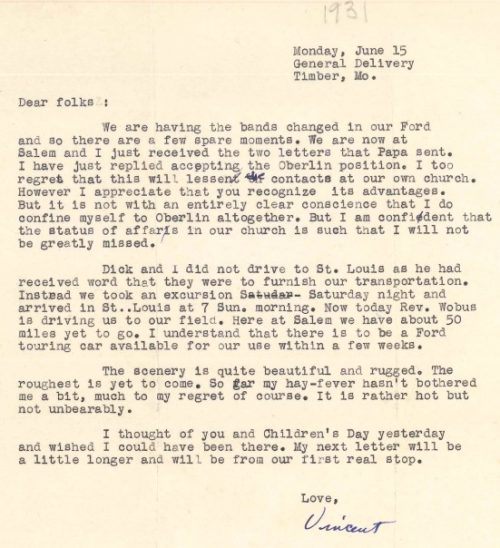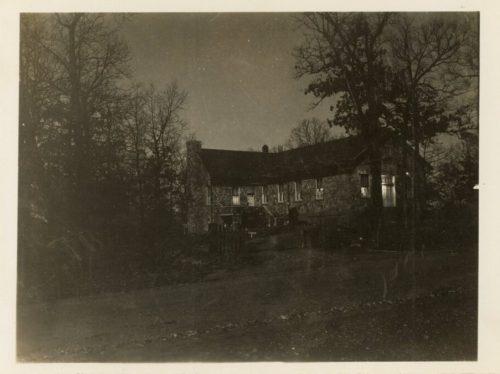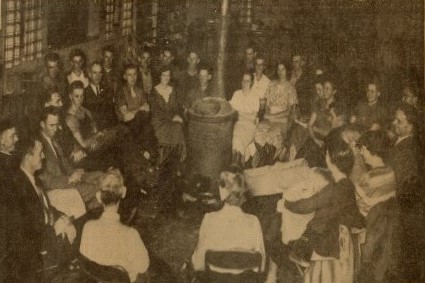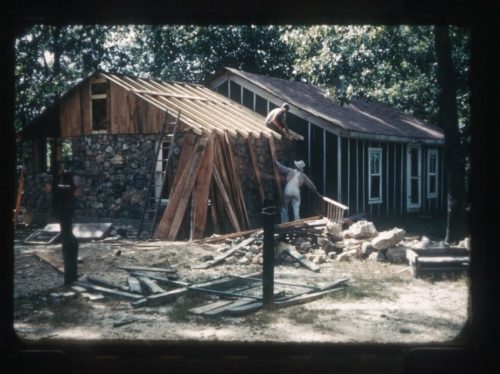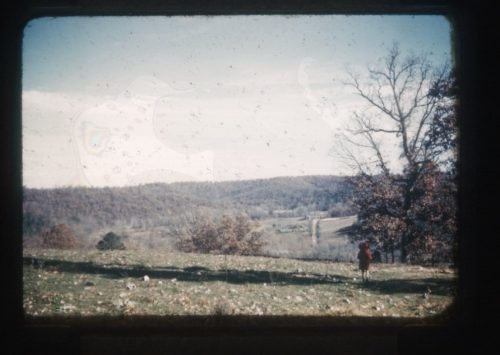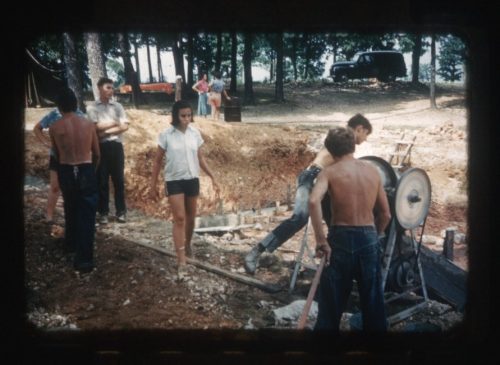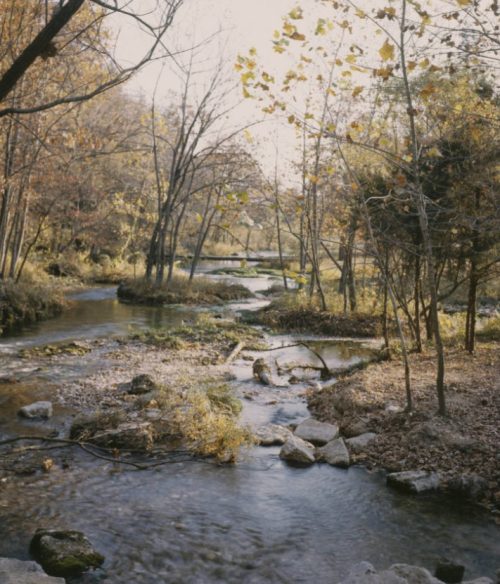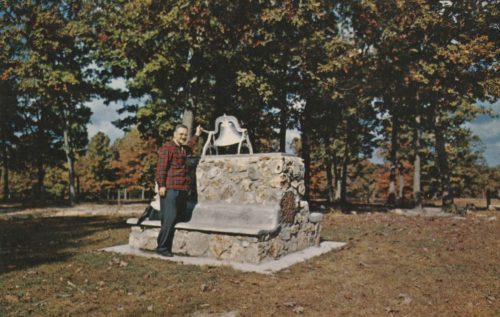![Vincent Bucher Vincent Bucher standing beside his father's collection of books, date unknown. [Ozark Stories of the Upper Current River, p. 64. SHS REF F586 V663]](https://historicmissourians.shsmo.org/wp-content/uploads/2025/08/Vincent-Bucher-scaled-300x340.jpg)
Vincent Bucher
Introduction
Vincent Bucher was a minister and conservationist from Shannondale, Missouri. Arriving in the Missouri Ozarks during the Great Depression, Bucher spent about thirty years in the region encouraging its people to support cooperative programs in which every member shared in the benefits and costs of education, agriculture, conservation, and religious worship.
Early Years
Vincent Bucher was born on November 23, 1907, in Canton, Ohio, to Theodore and Bessie Bucher. His father was a minister in the Reformed Church. His grandfather, Casper Theodore Bucher, had emigrated from Switzerland in the mid-nineteenth century and settled in St. Louis, Missouri. The family later moved to Ohio, but the four eldest Bucher children, including Theodore, were born in Missouri. After completing high school, Vincent Bucher earned degrees from Heidelberg College and Oberlin Graduate School of Theology, both in Ohio. In 1933 he married Ruth Beam, the daughter of John and Lillian Beam, who were Christian missionaries in China. Vincent and Ruth Bucher had three children together. Soon after they married, the couple moved to Nashville, Tennessee, where Vincent served as a minister of the First Evangelical Reformed Church.
Shannondale Community House
With millions of Americans struggling to support themselves during the Great Depression, Bucher accepted a job as pastor for the Evangelical and Reformed Church in Shannondale, Missouri, in 1934. He was somewhat familiar with the region as he had served as a visiting minister in the Ozarks since the early 1930s. Bucher became involved in the Shannondale Community House, which was established by Reverend Paul Wobus and the Evangelical and Reformed Church in Shannon County in 1929. The Community House was part of a larger mission program connecting St. Louis churches with rural communities. Efforts were also made to develop a cooperative program, or co-op, where goods and services are shared among the members. Those who belonged to the co-op shared a store, land for livestock grazing, farming tools, and transportation.
Folk School
Soon after arriving in Shannondale, Bucher set up plans for a school that blended religion with education and practical skills. The Folk School typically met at the Shannondale Community House but was sometimes held in neighboring towns. It featured courses on art, crafts, music, dancing, recreation, bookkeeping, cooking, sewing, carpentry, farming, forestry, health, history, politics, and the Bible. These courses were taught by local residents, including Vincent and Ruth Bucher, as well as by out-of-town experts such as traveling ministers, educators, and staff from the University of Missouri’s Extension Program.
As war loomed in Europe and Asia in the late 1930s, Bucher continued the Folk School curriculum, but also added discussions on military history, neutrality, peace, and pacifism (the belief that it is wrong to take part in wars or violence against other people). After the United States entered World War II in December of 1941, Bucher was drafted into the US military, but he was excused from service as a conscientious objector, or one who objects to serving in the military due to moral or religious principles. Rather than joining the military, Bucher devoted his efforts to helping war refugees who had been driven from their homes by the fighting.
The Shepherd of the Shannon Hills
By the mid-1940s, Vincent Bucher had become a community leader in Shannon and Dent Counties. In fact, his popularity led to an unsuccessful write-in campaign, where voters write in a person’s name instead of voting for one of the candidates already on the ballot, in 1944. Though he did not win enough votes to be elected to the Missouri House of Representatives, Bucher continued his community work. He started a youth camp where local children and teenagers, as well as national and international students, could spend part of their summer at the Shannondale Community House completing projects in the area, such as constructing barns and bridges, preventing water and soil erosion to farmland, and making improvements to nearby homes.
In 1949, Bucher took his interest in community cooperation and conservation a step further when he helped establish the 4,000-acre Shannondale Community Forest. Since the late 1800s, the trees of the Ozarks hill country had been cut down by lumber companies, leaving the land bare. After the lumber companies left, private and public organizations such as Leo Drey’s Pioneer Forest, the state’s Missouri Conservation Commission, and the US Forest Service helped restore the Ozark forests. The Shannondale Community Forest was meant to manage lumber harvesting, promote outdoor recreation for youth groups, and use the revenue from tree sales to fund local programs.
Ozark National Scenic Riverways
In the 1960s, the National Park Service (NPS) announced plans for a national monument to be established in the Ozark hill country around the Current and Eleven Point Rivers. Opponents of this monument, including Vincent Bucher, formed the Current–Eleven Point Rivers Association and lobbied in favor of a US Forest Service plan that would instead make the area part of a national forest. Their main objection to the NPS plan was that the department could declare eminent domain, which allowed them to buy land even if the owners did not want to sell it. The US Forest Service’s plan gave more control to landowners. Testifying before Congress, Bucher argued against the NPS plan. But Congress still selected the plan in 1964, and the Ozark National Scenic Riverways was dedicated in 1971.
Legacy
In 1961, Bucher received the rural pastor award from the Evangelical and Reformed Church for his service to the Shannondale community. A year later, he was elected chairman of the Ozark Division of the Missouri Association of Social Welfare. In 1967, Vincent and Ruth Bucher moved to a care facility in Pennsylvania for Ruth’s health. Vincent worked there as an activities director while continuing as a minister. After Ruth passed away in 1978, he married Elva Fritzsche Schmidt and moved with her to New York. She proceeded him in death in 1991. Vincent Bucher passed away on November 16, 1995.
Today, nearly a century after Vincent Bucher first greeted the residents of Shannon and Dent Counties, Shannondale Community House and Shannondale Forest continue on as symbols of his commitment to education, cooperation, and conservation.
Text and research by Doug Genens, Sean Rost, and Kathleen Seale
References and Resources
For more information about Vincent Bucher’s life and career, see the following resources:
Society Resources
The following is a selected list of books, articles, and manuscripts about Vincent Bucher in the research centers of The State Historical Society of Missouri. The Society’s call numbers follow the citations in brackets.
Articles from the Newspaper Collection
- “A Rural Social Center.” Weekly Kansas City Star. December 1, 1937. p. 3.
- Behymer, F. A. “He is Shepherd of the Shannon Hills.” St. Louis Post-Dispatch. July 25, 1947. p. 3D.
- “Church Forests serve Community in many ways.” Hannibal Courier-Post. April 10, 1951. p. 7.
- Coleman, Dorothy. “When Natives of the Missouri Ozarks hold their Folk School.” St. Louis Post-Dispatch. October 28, 1936. p. 3D.
- “Issues of the ‘Write-in-Bucher’ Campaign.” Shannon County Democrat. October 26, 1944. p. 5.
- “Rev. Bucher to head social welfare group.” West Plains Daily Quill. September 21, 1962. p. 1.
- “Shannondale Minister receives Evangelical Rural Pastor Award.” West Plains Daily Quill. April 26, 1961. p. 3.
- “Warns Park Plan will ruin culture.” West Plains Daily Quill. July 18, 1961. p. 1, 3.
- Frakes, Bob. Remembering Missouri’s Lookout Towers: A Place Above the Trees. Salem, Illinois: Words Matter Publishing, 2019. [REF F549.3 F8431]
- Shannondale United Church of Christ. Shannondale Quarterly. Salem, Missouri: Shannondale Community Center, 1991, 1992, 1999, 2000, 2001. [REF H2475.266 Sh19]
- Vickery, Margaret Ray. Ozark Stories of the Upper Current River. Salem, Missouri: Salem Publishing Company, n.d. [REF F586 V663]
- Bucher Family Papers (R1538)
The Bucher Family Papers contain correspondence between members of the Bucher family. Most of the letters are from Vincent Bucher in Shannondale, Missouri to his parents back in Ohio. Also included is a presentation about the first twenty years the Buchers spent in Shannondale consisting of 35mm slides and a script. - J. Andrew Stewart Papers (R1471)
The J. Andrew Stewart Papers contain the personal papers of J. Andrew ‘Andy’ Stewart dealing with his involvement with the Shannondale Community Center and Shannondale United Church of Christ. These materials include photographs, correspondence, church bulletins, pamphlets, devotionals and Bible studies. - Leo A. Drey Papers (S0531)
Leo A. Drey was an environmental activist and the owner of extensive tracts of Missouri land. Throughout his life, Drey was involved in many conservation projects, including the Natural Streams Act, Ozark National Scenic Riverways, and the Open Space Council. The collection includes correspondence, reports, meeting minutes, maps, legal materials, and newspaper clippings reflecting Drey’s interests in environmental issues in Missouri. - Missouri Environment Oral History Project (C3966)
Interviews with Missouri land use and natural resource professionals and other individuals related to the environment in Missouri. The records include audio cassettes, CDs, audio logs, and transcripts. - Paul A. Wobus Papers (R0008)
The Paul A. Wobus Papers contain the personal and professional papers of Reverend Paul A. Wobus of Manchester, Missouri. The papers include Wobus’s uncompleted and unpublished memoirs, photographs, correspondence, materials concerning Mount Zion Community Church and the Ozark Community Council, historical notes concerning Wobus’s avocational interest in the mills and railroads in the regions, miscellaneous newspaper clippings and other printed materials, narrative accounts of many of his trips into the Ozarks. Also included are 89 small notebooks, dated from 1938-1972, in which he kept records of his mileage, routes, schedules, expenses, and places and person visited. - Robert Q. Hamilton Papers (R1322)
The Robert Q. Hamilton papers contain personal papers associated with the family’s filling station, charcoal manufacturing, antique farm equipment at Timber in Shannon County, Missouri. The papers reflect the family’s close association with Shannondale Community Church Center, a mission of the Missouri Conference of the United Church of Christ. Other papers show civic involvement with the Timber volunteer fire department, recreation association, and North Shannon County Fair. - Shannondale Community Church-Center Collection (R0015)
The Shannondale Community Church-Center Collection contains copies of nine scrapbooks with printed material, letters, and photographs from the Shannondale Community Church-Center in Shannon County, Missouri. The materials detail the establishment of Shannondale and of various religions and social projects.
Outside Resources
These links will take you outside the Society’s website. The Society is not responsible for the content of the following websites:
- Shannondale Ministries
This website is hosted by the United Church of Christ Missouri Mid-South Conference and Shannondale Ministries, Shannondale Community Center, Wobus Craft Center, Froeschner Nature Center, and Bucher Memorial Tree Farm.

